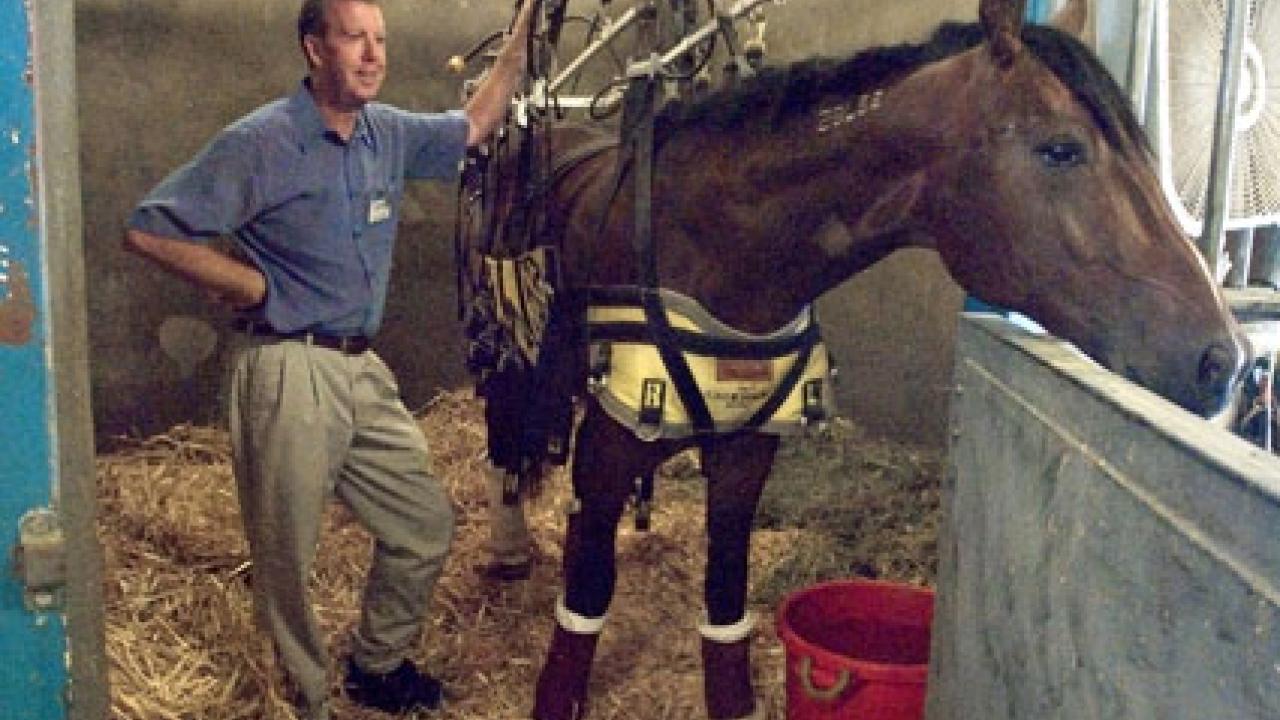First they put Barbaro in a Kimzey ambulance. Then they put a Kimzey splint on the racehorse's broken leg. And now the colt is in an Anderson sling several hours a day.
The ambulance, splint and sling all have links to the UC Davis School of Veterinary Medicine.
"We couldn't be prouder," said veterinarian John Madigan, a professor of medicine and epidemiology, and an equine specialist in the School of Veterinary Medicine, who helped develop the Anderson sling through his work at UC Davis.
"This is veterinary medicine's finest hour. It reflects on the caring and technical aspects of our profession."
People all over the world are paying attention, hoping for Barbaro's recovery from the injury that befell him just out of the starting gate in the Preakness Stakes on May 20. Two weeks earlier, the colt won the Kentucky Derby.
Reports on Barbaro's recovery appear almost daily in national and international news. "He's probably the world's most famous horse next to Seabiscuit," Madigan said.
"It's gratifying to know Barbaro is resting comfortably in our sling."
He actually seems to like it, according to a July 16 article in Newsday. "After spending several hours out of the sling two days ago, he walked back over to it and nudged it, as if to say, 'I want back in,' " the article states, quoting one of Barbaro's assistant trainers.
Madigan described how Barbaro sits back in the sling, like a dog sitting on its rear. Sitting like this, the horse takes all its weight off its legs.
Why horses avoid lying down
The alternative is lying down, which runs against a horse's physiology and nature. If a horse lies down for too long, its muscles will cramp and the gastrointestinal system will shut down — and the animal cannot get up, Madigan explained. In the wild, lying down for even a short period puts a horse at risk of predators.
"The sling has saved many horses that could not rise on their own or needed to be comfortably supported in the upright position while they recovered from an injury," Madigan said. The sling also is used when hoisting horses by helicopter, in rescue situations.
The sling comprises a rectangular metal structure, hoisted above a horse, and straps that hang from both sides of the structure. The straps connect to fabric that goes under the horse; buckles and snaps allow for adjustments to make the sling fit just right — holding up a horse by its skeletal system, with the animal's weight distributed evenly.
"It doesn't look that complicated, but it is," Madigan said. "Just changing a position (of a strap or buckle), you can't believe how that destabilizes a horse."
The process of developing the Anderson sling began in 1986 and took about eight years to complete. To craft the device, Madigan turned to Charlie Anderson, a welder in Potter Valley, Mendocino County, where Madigan maintained a private practice before joining the School of Veterinary Medicine. Richard Morgan, a vet med surgery technician who is now retired, also contributed to the development.
"We made over 100 modifications," Madigan said.
The Kimzey ambulance (priced at about $80,000) and leg splint ($252 to $486) are from Kimzey Welding Works Inc. in Woodland, and grew out of the company's work in the 1970s and '80s with Greg Ferraro when he was a racetrack veterinarian and president of the Southern California Equine Foundation. In 1998, Ferraro became director of the Center for Equine Health, part of the UC Davis School of Veterinary Medicine.
"It is personally rewarding to see that one's efforts so many years ago are still paying dividends to the welfare of horses today," Ferraro said. "I hope that this work and the work of others will continue, as we are far from solving all the problems associated with equine performance injuries."
Ferraro noted the ambulance's two key features: A hydraulic system that lowers the door to the ground; then, after a horse is rolled onto a stretcher, a winch pulls the stretcher onto the ambulance. Or, if a horse can walk, it can enter the ambulance without having to climb a ramp.
A movable wall within the ambulance can gently squeeze a standing horse, to help it stand during transport.
The "thoroughbred of ambulances," as described in a New York Times headline on May 26, hauled Barbaro from the Pimlico track in Baltimore to the University of Pennsylvania's New Bolton Center in Kennett Square, Pa.
There, veterinarians had access to yet another piece of equipment from Kimzey: a large-animal surgery table, developed in consultation with UC Davis' J.D. Wheat, now a professor emeritus in the School of Veterinary Medicine. Ferraro said he later worked with Kimzey on some table modifications and accessories.
The New Bolton team put forth a "remarkable" effort, Madigan said, in performing surgery to repair three breaks in Barbaro's right rear leg.
Wednesday, according to New Bolton's Web site, Barbaro was "doing well" in the intensive care unit as he recovered not only from his broken leg but a severe case of laminitis in his left hind foot — a result of favoring his right rear leg. Doctors removed about 80 percent of the horse's left rear hoof — then put him in the sling.
New Bolton reported a week ago that Barbaro's hind hoof "is slowly showing evidence of regrowth."
Media Resources
Dave Jones, Dateline, 530-752-6556, dljones@ucdavis.edu
